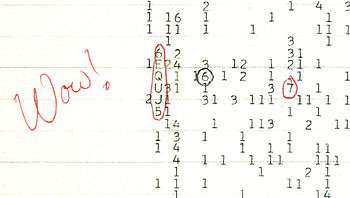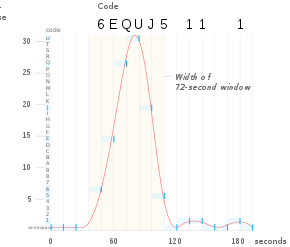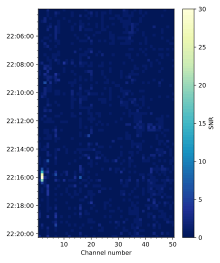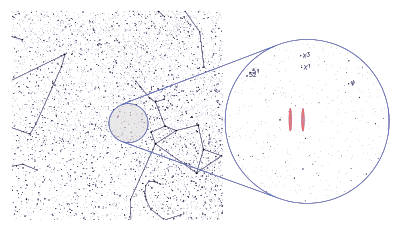Wow! signal

The Wow! signal was a strong narrowband radio signal received on August 15, 1977, by Ohio State University's Big Ear radio telescope in the United States, then used to support the search for extraterrestrial intelligence. The signal appeared to come from the constellation Sagittarius and bore the expected hallmarks of extraterrestrial origin.
Astronomer Jerry R. Ehman discovered the anomaly a few days later while reviewing the recorded data. He was so impressed by the result that he circled the reading on the computer printout and wrote the comment Wow! on its side, leading to the event's widely used name.[2]
The entire signal sequence lasted for the full 72-second window during which Big Ear was able to observe it, but has not been detected since, despite several subsequent attempts by Ehman and others. Many hypotheses have been advanced on the origin of the emission, including natural and man-made sources, but none of them adequately explains the result.[3] The Wow! signal remains the strongest candidate for an alien radio transmission ever detected.[3]
Background
In a 1959 paper, Cornell University physicists Philip Morrison and Giuseppe Cocconi had speculated that any extraterrestrial civilization attempting to communicate via radio signals might do so using a frequency of 1420 megahertz (21 centimeters), which is naturally emitted by hydrogen, the most common element in the universe and therefore likely familiar to all technologically advanced civilizations.[4]
In 1973, after completing an extensive survey of extragalactic radio sources, Ohio State University assigned the now-defunct Ohio State University Radio Observatory (nicknamed "Big Ear") to the scientific search for extraterrestrial intelligence (SETI), in the longest-running program of its kind in history. The radio telescope was located near the Perkins Observatory on the campus of Ohio Wesleyan University in Delaware, Ohio.
By 1977, Ehman was working at the SETI project as a volunteer; his job involved analyzing by hand large amounts of data processed by an IBM 1130 computer and recorded on line printer paper. While perusing data collected on August 15 at 22:16 EDT (02:16 UTC), he spotted a series of values of signal intensity and frequency that left him and his colleagues astonished.[4] The event was later documented in technical detail by the observatory's director.[5]
Signal measurement

The alphanumeric sequence circled by Ehman, 6EQUJ5, represents the intensity variation of the radio signal over time, measured as unitless signal-to-noise ratio and ranging from 0 to 36, with the noise averaged over the previous few minutes. Each individual character corresponds to a sample of the signal, taken every 12 seconds. A space character on the printout denotes an intensity between 0 and 1; the numbers "1" to "9" denote the correspondingly numbered intensities (from 1 to 9); intensities of 10 and above are indicated by a letter: "A" corresponds to intensities between 10 and 11, "B" to 11 to 12, and so on. The highest measured value was "U" (an intensity between 30 and 31), that is thirty times stronger than normal background noise.[2][6]
A common misconception is that the Wow! signal constitutes some sort of message. In fact, what was received appears to be an unmodulated, continuous wave signal with no encoded information; essentially a flash of radio energy. The string "6EQUJ5" is merely the representation of the expected variation of signal intensity over time, expressed in the particular measuring system adopted for the experiment.[7]
Frequency
Two different values for the signal's frequency have been given: 1420.36 MHz (J. D. Kraus) and 1420.46 MHz (J. R. Ehman), both very close to the value of 1420.41 MHz of the hydrogen line, as predicted by Morrison and Cocconi. The two values are nearly the same distance from the hydrogen line—the first 0.04975 MHz (49.75 kHz) below and the second 0.04985 MHz (49.85 kHz) above.[8]

Ehman analyzed the discrepancy between the two published frequencies. He concluded that an oscillator, which became the first local oscillator (LO), was ordered for the frequency of 1450.4056 MHz. However, the university's purchasing department made a typographical error in the order and wrote 1450.5056 MHz (i.e., 0.1 MHz higher than desired). The software used in the experiment was then written to adjust for this error. When Ehman computed the frequency of the Wow! signal, he took this error into account.
Time variation
At the time of the observation, the Big Ear radio telescope was only adjustable for declination (or height above the horizon), and relied instead on the rotation of the Earth to scan across the sky. Given the speed of Earth's rotation and the spatial width of the telescope's observation window, the Big Ear could observe any given point for just 72 seconds.[3] A continuous extraterrestrial signal, therefore, would be expected to register for exactly 72 seconds, and the recorded intensity of such signal would display a gradual increase for the first 36 seconds—peaking at the center of the observation window—and then a gradual decrease as the telescope moved away from it. All these characteristics are present in the Wow! signal.[9][10]
Bandwidth
The Wow! signal was a narrowband emission: its bandwidth was less than 10 kHz. The Big Ear telescope was equipped with a receiver capable of measuring fifty 10 kHz-wide channels. The output from each channel was represented in the computer printout as a column of alphanumeric intensity values. The Wow! signal is essentially confined to one column.[8]
Celestial location

The precise location in the sky where the signal apparently originated is uncertain due to the design of the Big Ear telescope, which featured two feed horns, each receiving a beam from slightly different directions, while following Earth's rotation. The Wow! signal was detected in one beam but not in the other, and the data was processed in such a way that it is impossible to determine which of the two horns received the signal.[11] There are, therefore, two possible right ascension (RA) values for the location of the signal (expressed below in terms of the two main reference systems):[12]
B1950 equinox J2000 equinox RA (positive horn) 19h22m24.64s ± 5s 19h25m31s ± 10s RA (negative horn) 19h25m17.01s ± 5s 19h28m22s ± 10s
In contrast, the declination was unambiguously determined to be as follows:
B1950 equinox J2000 equinox Declination −27°03′ ± 20′ −26°57′ ± 20′
The region of the sky in question lies northwest of the globular cluster M55, in the constellation Sagittarius, roughly 2.5 degrees south of the fifth-magnitude star group Chi Sagittarii, and about 3.5 degrees south of the plane of the ecliptic. The closest easily visible star is Tau Sagittarii.[13]
Hypotheses on the signal's origin
A number of hypotheses have been advanced as to the source and nature of the Wow! signal. None of them have achieved widespread acceptance.
Interstellar scintillation of a weaker continuous signal—similar in effect to atmospheric twinkling—could be an explanation, but that would not exclude the possibility of the signal being artificial in origin. The significantly more sensitive Very Large Array did not detect the signal, and the probability that a signal below the detection threshold of the Very Large Array could be detected by the Big Ear due to interstellar scintillation is low.[14] Other hypotheses include a rotating lighthouse-like source, a signal sweeping in frequency, or a one-time burst.[12]
Ehman has said: "We should have seen it again when we looked for it 50 times. Something suggests it was an Earth-sourced signal that simply got reflected off a piece of space debris."[15] He later recanted his skepticism somewhat, after further research showed an Earth-borne signal to be very unlikely, given the requirements of a space-borne reflector being bound to certain unrealistic requirements to sufficiently explain the signal.[8] Also, it is problematic to propose that the 1420 MHz signal originated from Earth since this is within a protected spectrum: a bandwidth reserved for astronomical purposes in which terrestrial transmitters are forbidden to transmit.[16][17] In a 1997 paper, Ehman resists "drawing vast conclusions from half-vast data"—acknowledging the possibility that the source may have been military or otherwise a product of Earth-bound humans.[18]
METI president Douglas Vakoch told Die Welt that any putative SETI signal detections must be replicated for confirmation, and the lack of such replication for the Wow! signal means it has little credibility.[19]
In a 2012 podcast, scientific skeptic author Brian Dunning concluded that a radio transmission from deep space in the direction of Sagittarius, as opposed to a near-Earth origin, remains the best technical explanation for the emission, although there is no evidence to conclude that an alien intelligence was the source.[3]
In 2017, Antonio Paris proposed that the hydrogen cloud surrounding two comets, 266P/Christensen and 335P/Gibbs, now known to have been in roughly the right position, could have been the source of the Wow! signal.[20][21][22] However, this theory has attracted strong criticism, including from members of the original Big Ear research team, as a more detailed analysis shows the cited comets were not in the beam at the correct time. Furthermore, comets are not radio-bright at these frequencies, and there is no explanation for why a comet would be observed in one beam but not in the other.[23][24]
Searches for recurrence of the signal
Several attempts were made by Ehman and other astronomers to recover and identify the signal. The signal was expected to occur three minutes apart in each of the telescope's feed horns, but that did not happen.[10] Ehman unsuccessfully searched for recurrences using Big Ear in the months after the detection.[14]
In 1987 and 1989, Robert H. Gray searched for the event using the META array at Oak Ridge Observatory, but did not detect it.[14][25] In a July 1995 test of signal detection software to be used in its upcoming Project Argus, SETI League executive director H. Paul Shuch made several drift-scan observations of the Wow! signal's coordinates with a 12-meter radio telescope at the National Radio Astronomy Observatory in Green Bank, West Virginia, also achieving a null result.
In 1995 and 1996, Gray again searched for the signal using the Very Large Array, which is significantly more sensitive than Big Ear.[14][25] Gray and Simon Ellingsen later searched for recurrences of the event in 1999 using the 26-meter radio telescope at the University of Tasmania's Mount Pleasant Radio Observatory.[26] Six 14-hour observations were made at positions in the vicinity, but nothing like the Wow! signal was detected.[10][25]
Response
In 2012, on the 35th anniversary of the Wow! signal, Arecibo Observatory beamed a digital stream toward the area of the signal's origin. The transmission consisted of approximately 10,000 Twitter messages solicited for the purpose by the National Geographic Channel, bearing the hashtag "#ChasingUFOs" (a promotion for one of the channel's TV series).[27] The sponsor also included a series of video vignettes featuring verbal messages from various celebrities.[28]
To increase the probability that any extraterrestrial recipients would recognize the signal as an intentional communication from another intelligent life form, Arecibo scientists attached a repeating-sequence header to each individual message, and beamed the transmission at roughly 20 times the wattage of the most powerful commercial radio transmitter.[27]
In popular culture
- In 1995, H. Paul Shuch composed the filk song Ballad of the "Wow!" Signal,[29] which is sung to the tune of Ballad of Springhill by Peggy Seeger.[30]
- In 2016, Jean-Michel Jarre released the Oxygène 17 music video[31] which is dedicated to the Wow! signal.
- In 2012 The Dandy Warhols released the song "Seti vs. the Wow! Signal".
- In a 2017 Super Bowl commercial spoofing conspiracy theories such as the moon landing hoax, Area 51, and subliminal advertising, the base of a stone monolith carries the inscription "6EQUJ5".[32][33]
- The Wow! signal was mentioned in The X-Files episode "Little Green Men".
- The Wow! signal is used as the source of the alien power suit in the movie Lazer Team.
- The Wow! original printout is one of the images in an exposition montage in The Beyond, a science fiction film.
See also
- Arecibo message, a 3-minute-long message sent into space
- Fast radio burst
- KIC 8462852, "Tabby's star"
- Radio signal from HD 164595
- Radio source SHGb02+14a
References
- ↑ Wood, Lisa (July 3, 2010). "WOW!". Ohio History Connection Collections Blog. Retrieved 2016-07-02.
- 1 2 Krulwich, Robert (May 29, 2010). "Aliens Found In Ohio? The 'Wow!' Signal". National Public Radio. Retrieved 2016-07-02.
- 1 2 3 4 Dunning, Brian. "Skeptoid #342: Was the Wow! Signal Alien?". Skeptoid. Retrieved 2016-10-08.
- 1 2 Kiger, Patrick J. (2012-06-21). "What is the Wow! signal?". National Geographic Channel. Retrieved 2016-07-02.
- ↑ John Kraus, Director, Ohio State Radio Observatory 31, January 1994, “The Tantalizing WOW! Signal”, Copy of letter to Carl Sagan containing an unpublished paper describing the event.
- ↑ Ehman, Jerry. "Explanation of the Code "6EQUJ5" On the Wow! Computer Printout". Retrieved 2016-07-02.
- ↑ Shuch, H. Paul. "SETI Sensitivity: Calibrating on a Wow! Signal". SETI League. Retrieved 2016-06-25.
- 1 2 3 Ehman, Jerry R. (February 3, 1998). "The Big Ear Wow! Signal. What We Know and Don't Know About It After 20 Years". Retrieved 2016-07-02.
- ↑ "EDN Moments". Retrieved 2016-07-02.
- 1 2 3 Shostak, Seth (2002-12-05). "Interstellar Signal From the 70s Continues to Puzzle Researchers". Space.com. Retrieved 2016-07-02.
- ↑ "Big Ear's Twin Feed Horns". Retrieved 2016-07-02.
- 1 2 Gray, Robert; Marvel, Kevin (2001). "A VLA Search for the Ohio State 'Wow'" (PDF). The Astrophysical Journal. 546 (2): 1171–77. Bibcode:2001ApJ...546.1171G. doi:10.1086/318272.
- ↑ Ehman, Jerry R. (May 28, 2010). "The Big Ear Wow! Signal (30th Anniversary Report)". North American AstroPhysical Observatory. Retrieved 2016-07-02.
- 1 2 3 4 "The 'Wow!' Signal". Discovery Channel. Retrieved 2016-07-02.
- ↑ Kawa, Barry (1994-09-18). "The Wow! signal". Cleveland Plain Dealer. Retrieved 2016-07-02.
- ↑ "Significant Radio Astronomy Frequencies". SETI League. Retrieved 2016-07-02.
- ↑ Committee on Radio Astronomy Frequencies Handbook for Radio Astronomy (PDF) (3rd ed.). European Science Foundation. 2005. p. 101.
- ↑ Frank, Adam (July 10, 2012). "Talking To Aliens From Outer Space". NPR. Retrieved 2016-07-02.
- ↑ Marsiske, Hans-Arthur (2007-09-12). "Welche Sprache sprechen Außerirdische?". Die Welt.
- ↑ Paris, Antonio (1 January 2016). "Hydrogen Clouds from Comets 266/P Christensen and P/2008 Y2 (Gibbs) are Candidates for the Source of the 1977 "WOW" Signal". Journal of the Washington Academy of Sciences. Archived from the original on 15 June 2017. Retrieved 13 June 2017.
- ↑ Paris, Antonio (1 April 2017). "Hydrogen Line Observations of Cometary Spectra at 1420 MHZ". Journal of the Washington Academy of Sciences. 103 (2). Retrieved 13 June 2017.
- ↑ https://arxiv.org/abs/1706.04642
- ↑ Dixon, Robert S, Dr. "Rebuttal of the claim that the "WOW!" signal was caused by a comet". NAAPO. North American Astrophysical Observatory. Retrieved 13 June 2017.
- ↑ Emspak, Jesse (11 January 2016). "Famous Wow! signal might have been from comets, not aliens". New Scientist. Retrieved 13 June 2017.
- 1 2 3 Gray, Robert H (2012). The Elusive WOW: Searching for Extraterrestrial Intelligence. Chicago: Palmer Square Press. ISBN 978-0-9839584-4-4.
- ↑ Gray, Robert; Ellingsen, S. (2002). "A Search for Periodic Emissions at the Wow Locale". The Astrophysical Journal. 578 (2): 967–71. Bibcode:2002ApJ...578..967G. doi:10.1086/342646.
- 1 2 Wolchover, Natalie (2012-06-27). "Possible Alien Message to Get Reply from Humanity". Discovery News.
- ↑ "Humanity Responds to 'Alien' Wow Signal, 35 Years Later". Space.com. 2012-08-12.
- ↑ Ballad of the Wow! Signal, sung by Dr. SETI (

- ↑ H. Paul Shuch: Ballad of the "Wow!" Signal, SETI League Songbooks
- ↑ Oxygene Pt. 17. YouTube.
- ↑ Avocados From Mexico - Secret Society (Super Bowl 2017 Commercial) (video). YouTube: Avocados from Mexico. 2017-02-01. Retrieved 2018-04-16.
- ↑ Kuperinsky, Amy (2017-02-06). "Watch the 10 best Super Bowl 2017 commercials". NJ.com. New Jersey On-Line. Retrieved 2017-08-15.
External links
| Wikimedia Commons has media related to Wow! signal. |
- Location on Google Sky
- Location on YourSky